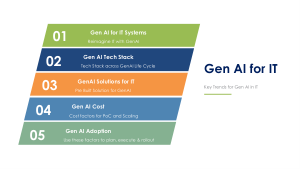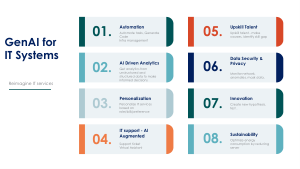CTO and CIO Guide: Implementing Generative AI for IT Operations

SLIDE1 |

SLIDE2 |

SLIDE3 |

SLIDE4 |
CTO and CIO Guide: Implementing Generative AI for IT OperationsGenerative AI (GenAI) is becoming an essential tool for IT organizations, offering opportunities to streamline operations, enhance automation, and enable innovation. This guide provides an overview of how CTOs and CIOs can integrate GenAI into IT operations, covering use cases, cost considerations, KPIs, and key factors for success. 1. Key Use Cases of Generative AI in IT OperationsA. Automating IT Support and Operations
B. Infrastructure Monitoring and Incident Management
C. Software Development & Code Generation
D. Security Operations
E. Capacity Planning & Resource Optimization
F. Data Management and Governance
2. Cost Considerations for GenAI ImplementationImplementing GenAI within IT requires a balance between potential ROI and up-front investment. Here are some key factors to consider: A. Infrastructure Costs
B. Model Training and Deployment
C. Integration with Existing Systems
D. Talent and Skills
3. KPIs to Measure Success in GenAI ImplementationTracking performance and ROI is critical for the success of GenAI projects. Key performance indicators (KPIs) should focus on both operational efficiency and business outcomes: A. Operational Efficiency KPIs
B. Cost and Productivity KPIs
C. Customer Satisfaction KPIs
D. Security KPIs
4. Factors for Successful GenAI Implementation in ITTo ensure successful adoption of GenAI in IT, there are several strategic, technical, and organizational factors that CTOs and CIOs should consider. A. Data Strategy
B. AI Governance
C. IT and AI Integration
D. Change Management
5. ConclusionIntegrating Generative AI into IT operations has the potential to drive significant efficiency gains, reduce costs, and enhance innovation. However, the success of such initiatives depends on strategic planning, investment in talent and infrastructure, and robust performance tracking. CTOs and CIOs should focus on key use cases such as automation, infrastructure monitoring, and security, while keeping a close eye on cost management and measurable KPIs. By taking a structured approach, companies can unlock the full potential of GenAI in IT and stay ahead in the rapidly evolving tech landscape. |
Ai-assitant-for-banking Gen-ai-for-it-operations Genai-for-asset-management Genai-for-asset-mgmt-and-trad Genai-for-compliance-manageme Genai-for-it-operations Genai-implementation-in-tradi Genai-supply-chain Genai-use-cases Generative-ai-for-data-privacy